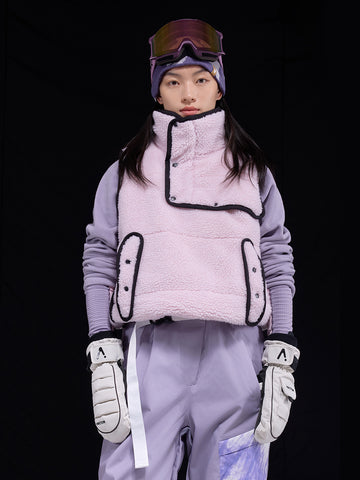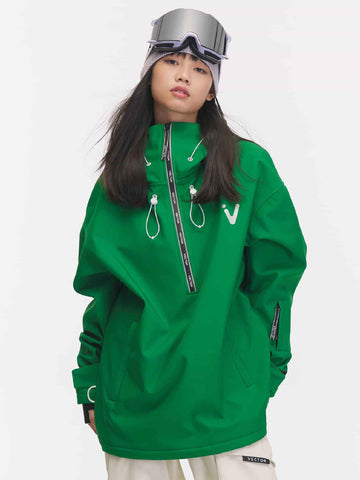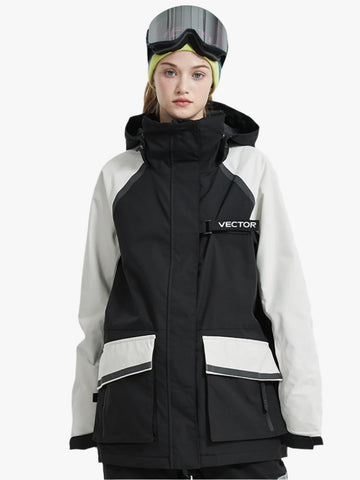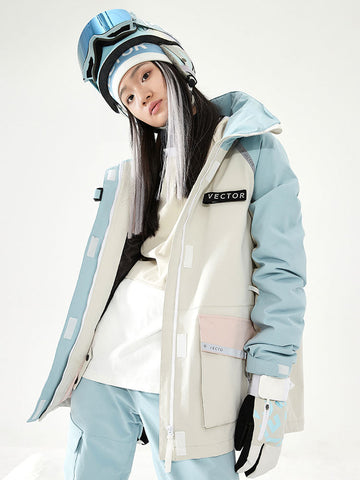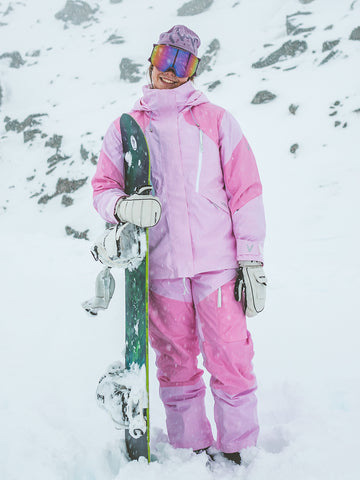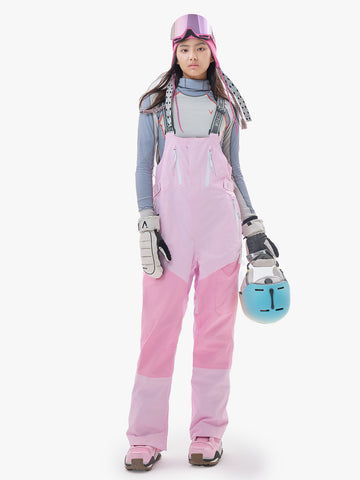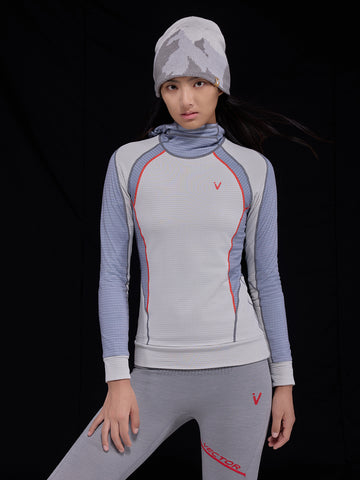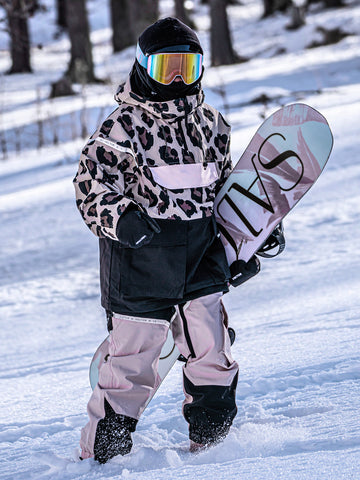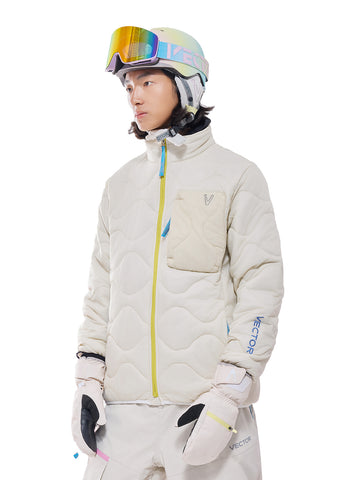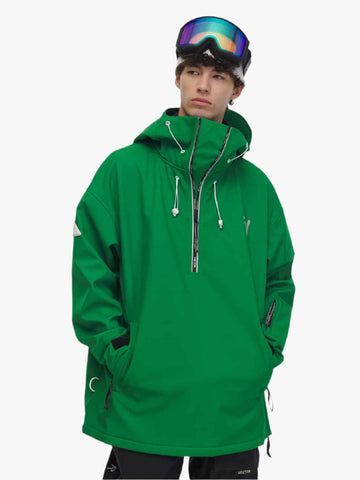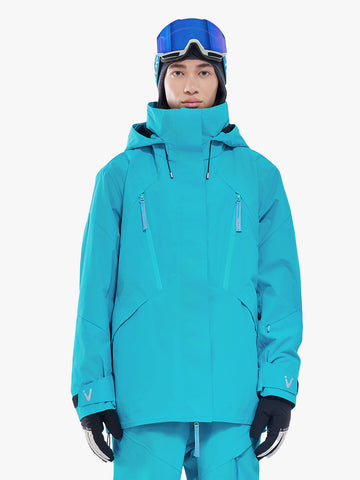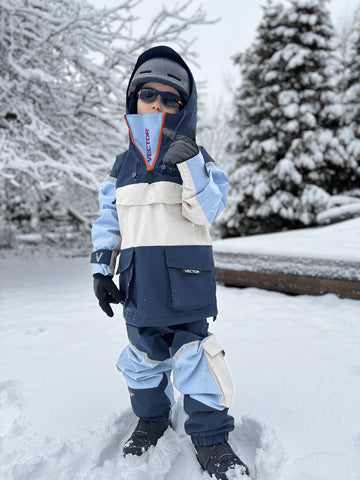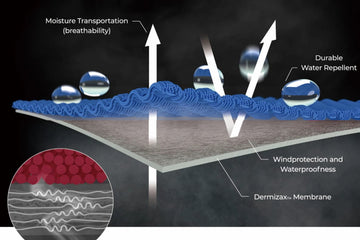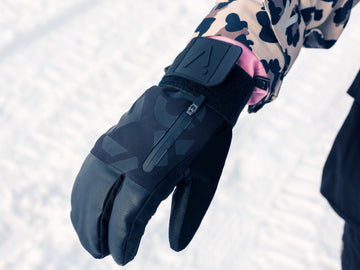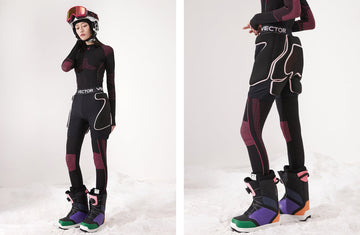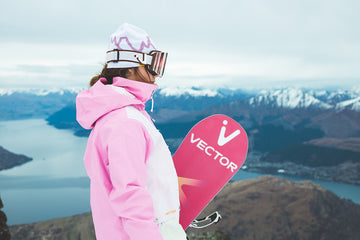It's easy to keep your body warm when snowboarding by choosing a suitable men's snow jacket, but for your hands, not so easy. Regular gloves won't cut it because they can't keep your hands warm while moving, and they don't have shells, which makes them easier to get wet, making it colder. Therefore, a pair of suitable and warm men's snowboard gloves is very important.
What should you know about men's snowboard gloves
1. The Anatomy
There are five main portions of men's snowboard gloves that need to be considered:
- Shell
- Membrane
- Insulation
- Lining
- Palm
Let’s take a closer look at these five parts:
1.1 Shell
Shell is the outermost part of a snowboard glove, which usually functions as windproof, waterproof and protective glove. Shell is mainly made from two materials: synthetic or leather.
1.1.1 Synthetic
Synthetic gloves, usually made of nylon because nylon is one of the most abrasion-resistant materials. Synthetic gloves are usually waterproof, breathable, and coated on the surface, usually ePTFE (expanded Polytetrafluoroethylene, AKA Teflon®) or PU (polyurethane). These waterproof fabrics usually come in softshell or hardshell and are widely used in snowboard gloves.
1.1.2 Leather
Leather gloves, usually made from cowhide or goatskin, are naturally waterproof, softer and tougher than synthetic materials, and are often coated with wax or grease for protection. Leather materials are treated to create a membrane that makes them windproof, water-resistant and more insulating than synthetic materials. These gloves can last for years if you maintain them properly, though you’ll need to pay much more for it.
1.2 Membrane
Inadequate waterproofing in gloves can lead to discomfort, leaving our hands wet and chilly, detracting you from enjoy snowboarding. Primarily, this wetness arises from poor breathability, hindering the removal of sweat from our hands.
High-quality snowboarding gloves feature a specialized membrane situated between the outer shell and inner lining. This membrane is studded with numerous minuscule pores, effectively repelling water while facilitating the escape of hand sweat in the form of water vapor.
Let's now explore some commonly employed membrane materials.
1.2.1 Gore-TEX®
GORE-TEX® has always been the leader in ski/snowboard clothing and accessories. Having a Gore-TEX membrane usually means that this men's snowboarding glove has the highest waterproof and breathable grade on the market.
1.2.2 Hipora®
Hipora features a three-layer membrane with a polyurethane (PU) coating, recognized for its superior stretchability compared to other PU coatings. The polyurethane coating is peppered with minuscule pores, ensuring that the snowboard glove remains waterproof, windproof, and breathable.
1.2.3 Polyurethane
Polyurethane (PU) coated fabric is a dominant player in the glove market. Renowned for its commendable waterproofing and breathability, it also holds a competitive edge in terms of pricing. Numerous manufacturers leverage proprietary technologies to craft PU fabric, often integrating it with complementary materials for enhanced performance.
1.2.4 Windstopper®
Created by GORE, it is an ePTFE fabric that is not waterproof but is excellent at being windproof and breathable. Ski gloves made from this fabric have fewer layers and are more flexible.
WINDSTOPPER® items are usually coated with a DWR (Durable Water Repellent), providing a degree of waterproofing, but it is still possible to get wet in heavy rain.
1.3 Insulation
Two basic insulation types are commonly used in gloves and mittens: down and synthetic.
1.3.1 Down
Down possesses exceptional warmth and lightweight properties. It is highly voluminous, light in weight, and easy to compress, making it a favorite among skiers. However, when down gets wet, it becomes cold and heavy, so it is more suitable for dry winter conditions.
1.3.2 Synthetic
Synthetic insulation materials are not as expensive as down, they can quickly dry even in humid environments and still keep functional, making them an excellent choice for damp conditions. However, they provide less warmth and are thicker and heavier compared to down. If you're going to downhill skiing, cross-country skiing, and snowboarding, then synthetic gloves might be a good choice.
1.4 Lining
The lining refers to the innermost part of the glove that is in direct contact with the skin. They will directly affect how you like the glove. Good men's snowboard glove padding provides a warm, comfortable feel and wicks sweat from your hands to the membrane. The lining is usually made of wool or synthetic wool.
1.5 Palm
For enhanced durability, most snowboards and ski gloves come equipped with grips and reinforcement in high-used areas like palms, fingertips, and thumbs. These areas may be made from a variety of materials such as leather, vinyl, and occasionally silicone.
2. The Types
Snowboard gloves can basically be divided into four types:
- Gloves
- Mittens
- Lobster Gloves
- 3-In-1
Again, let’s take a closer look at what's the difference between them:
2.1 Gloves
Gloves offer superb comfort, though they may not provide the same level of warmth as mittens. If you're into high-energy activities like cross-country skiing, where heat is abundant, gloves are the perfect choice to keep you comfortable and in control.

Vector Nova Snowboard & Ski Gloves
2.2 Mittens
Mittens are warmer than gloves made of the same material because your fingers share the warmth and it has a smaller surface. But mittens may not be as flexible as gloves in movement. However, many manufacturers now design a zipper on the palm of the mittens, and you can directly open the zipper to expose your fingers.
2.3 Lobster Gloves
Lobster mitts, or three-finger gloves. Some suppliers produce hybrid versions of gloves and mittens, creating a glove that is more like a lobster claw. If you feel like gloves aren't warm enough and mittens are too bulky, this might be a good option.
Vector Kevlar® 3-Finger Snowboard & Ski Gloves
2.4 3-In-1
3-in-1, or liner Gloves & pipe Gloves. Consists of a shell glove or mitt and an inner glove or mitt. This combination has a wide range of uses, you can use one of them alone when you're feeling hot or combine them for maximum warmth.
Vector Snowboard & Ski Glove Liner
How to choose suitable men's snowboard gloves
We have seen how to choose the material, type and function of gloves and mittens. Now we need to examine more details as they can also have a big impact.
1. The Fit
A properly sized pair of gloves can keep your hands warm and flexible. Gloves that are too big will make it difficult to perform tasks, and gloves that are too small will hinder your mobility and expose the skin around your wrist. Make sure your gloves still have 1/4 inch at the end of your fingers and try making a fist while wearing the gloves to ensure they fit properly.
2. The Design
2.1 Cuff Style
How to choose the cuff length of your snowboard gloves or mittens usually comes down to your personal preference, but your men's snow jacket may be one of the factors you want to consider. Some snowboard gloves or mitten cuffs are designed to be worn under a jacket, while others are meant to be worn over it.
2.2 Zippered Pockets
Usually located on the back of the hand, it is typically for disposable hand warmers you can insert for colder days or store your ID card. The opening may double as a vent when temperatures increase.
Vector Polar Detachable Kevlar® Snowboard & Ski Mittens
2.3 Wrist Guard
Gloves or mittens with wrist guards are often used on snowboards to help protect the wrists from impact trauma. A reasonable wrist guard design should be to design a pocket on the cuff of the glove that extends toward the palm and put a wrist guard in the pocket. This design can better protect the wrist, and the wrist guard can be removed when the wrist guard is not needed. Take it out and be more flexible.
2.4 Wrist Loops
Prevent your ski gloves or mittens from getting lost while skiing by attaching them to your wrist or jacket so that if your ski gloves or mittens fall, they won't be lost far.
2.5 Touch-Screen Fingertips
Many manufacturers are attaching touchscreen-compatible materials to the fingers of gloves to allow players to operate smartphones without having to take off the gloves. These gloves offer some flexibility, so consider them if you use your phone a lot outdoors, but keep in mind that these materials may fall off after heavy use.
2.6 Wipes
Some gloves or mittens feature chamois or other absorbent, soft material on the sides of the thumb to make it easier for you to wipe your nose in cold conditions.
2.7 Squeegee
To make it easier for you to scratch your men's snow goggles, some manufacturers put rubber scrapers on the thumb seams of gloves or mittens.
Summary
This is all about how to buy suitable men’s snowboard gloves or mittens. If you’ve read this far, congratulations, you have all the knowledge you need to get fit gloves or mittens.
Welcome to check out the Vector collection of men's snowboard gloves and mittens:https://www.vectorofficial.com/collections/glove-mittens
FAQ
1. How to take care of my snow gloves?
A good pair of snow gloves or mittens is an investment, you can extend its life by doing this:
After use, wait for them to dry completely before storing them in the bag to prevent mold and odor. Do not use a hair dryer or radiator to dry the gloves as the heat will destroy the material. If your liner is not sewn onto the glove, then you can remove the liner and stand it up to allow air to flow.
2. How often should I wash my snow gloves?
1-2 times per season is enough. Please try to hand wash to avoid damaging the gloves.
3. How do I store my ski gloves when the season is over?
When storing ski gloves at the end of the season, it's important to avoid leaving them in direct sunlight, as prolonged exposure can damage the material. Similarly, refrain from storing them in damp places, as this can lead to odors and mold. Opt for a dark, dry environment instead. However, be vigilant about potential issues with bugs and dust. Regular maintenance is key to extending the lifespan of your gloves. Consider placing them in a basket or hanging them on hooks, allowing for proper airflow to keep them in good condition.
4. What are the differences between gloves used for snowboarding and skiing?
Snowboarding gloves need to be more flexible because your hands need to maintain balance and control the board. Gloves for skiing require more grip and control. Snowboarding gloves require more wear resistance because your hands constantly contact the ground during snowboarding. Ski gloves, on the other hand, focus more on comfort. So before you buy your snow gloves or mittens, make sure you have considered these points.
Contact
We are always here to help, feel free to contact us if you have any questions.
See other useful articles
How to choose snowboard pants& bibs: https://www.vectorofficial.com/blogs/guide/how-to-choose-snowboard-pants-bibs
Ultimate women's snowboard jacket buying guide of 2023: https://www.vectorofficial.com/blogs/guide/ultimate-women-snowboard-jacket-buying-guide-of-2023
How to measure glove size: https://propercloth.com/reference/how-to-measure-glove-size/
How to take care of your ski & snowboard gloves: https://www.freethepowder.com/pages/washing-cleaning-ski-gloves
You can also follow us at the bottom of the page to stay up to date with our latest news and promotions.



